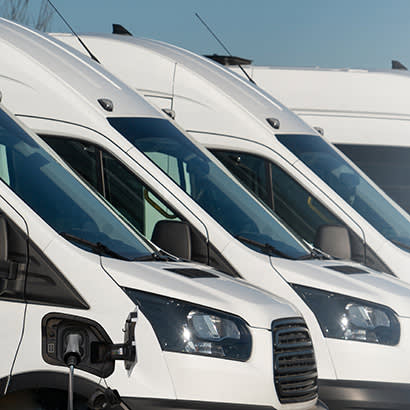
For an enhanced digital experience, read this story in the ezine.
As stewards of park and recreation spaces, we stand at an exciting crossroads between strategy, innovation and conservation when it comes to sustainable fleet management. Is there an electric vehicle that could replace your current gas-powered one? Do you need it, or could you simply optimize the route or select a vehicle of a different size from your fleet? These are some key questions we recently discussed with park sustainability experts who shared great insight into the creative ways that they are embedding sustainable practices into their fleet management.
Assess Your Needs
Take a look at your current fleet. What operations require a full-size pickup and what can be accomplished with a smaller, more energy-efficient electric vehicle? Using the right vehicle for the right task is crucial, and park staff have seen great success adapting vehicle sizes to appropriate needs and tasks.
In Louisville, Kentucky, park staff also identified the need to enforce a strict no-idling policy, resulting in a reduction of gas usage by an impressive 33 percent. Seve Ghose, currently the executive director of Yerba Buena Gardens Conservancy in San Francisco, shared this context with his team: “Let’s say you mow for an hour in a particular park — that’s the equivalent of 10 cars idling for that same amount of time.” Storytelling, signage and marketing are key motivators for staff and the community, providing context in favor of these transitions.
In Louisville, the third largest heat-island city in the country, staff and community members have expressed immense gratitude for the no-idling policy and the transition to electric fleets, because they are no longer regularly inhaling exhaust fumes or subject to noise pollution. Todd Burley, sustainability advisor of Seattle Parks and Recreation, notes that in addition to the environmental and community benefits of electric fleets, there is an improved quality of life for the individuals using these electric tools, as they are generally much lighter and safer to use. Tree crews have embraced the switch to electric handheld equipment because it enables them to start them up directly in the trees. One park staff member shares, “I go home and not only am I not deaf, but my hands aren’t shaking from the vibration of the gas mower that I’ve sat on for eight hours.”
Emphasize Naturalization
Many parks let their grass grow during the coronavirus (COVID-19) pandemic, and the public was elated to notice wildflowers growing and wildlife returning. Paired with messaging about pollinator habitat, many parks shifted their well-trimmed grass fields into meadows that became safe spaces for the public to have picnics and play sports in harmony with natural ecosystems.
In Portland, Oregon, this transition cut down the frequency of mowing as well as the overall number of acres mowed from about 30 acres to 1,500 acres of no-mow land in four years. The change reduces emissions, increases efficiencies and cuts down on time and fuel. Even letting grass grow an inch or two higher can cut the carbon footprint significantly, relieve the load on equipment and have a positive cascading effect throughout operations.
Be Deliberate and Intentional
Pick a few pilot project areas with buy-in from staff and collect data. Ghose shares, “[We are] not trying to change the whole city and the whole system or all the crews in one go. You pick an area, and that crew then becomes your advocate, your spokesperson to make that bigger change, so that you’re not trying to push all the buttons all the time.” The cultural shift toward safer and more resilient parks takes time, but with ecosystems, health and equity all benefiting, it is well worth it.
NRPA understands that these emerging trends require continued awareness and adaptability to each park’s unique circumstances and is here to support you as we continue to learn and grow together. Connect and collaborate with other park and recreation professionals through NRPA Connect to ask clarifying questions, troubleshoot unique problems, celebrate successes and tune in to more information on this topic soon.
Stephanie Whyte is Resilience Program Manager at NRPA.


